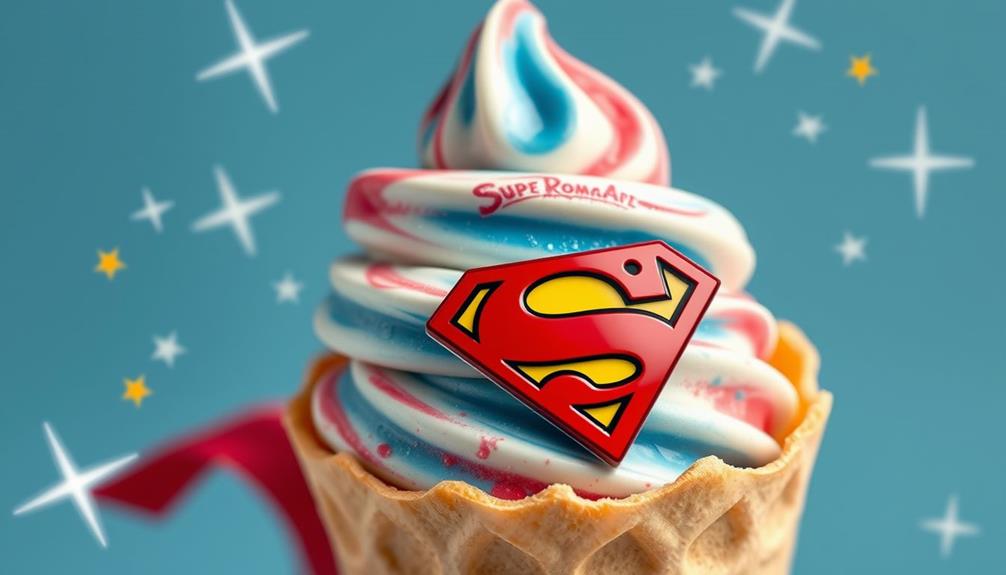Yes, homemade ice cream can go bad if not stored properly. It typically lasts 1-2 weeks in the freezer, but signs like off flavors, ice crystals, freezer burn, or unusual odors mean it’s time to toss it. Proper storage in airtight containers at a consistent 0°F helps extend its freshness. Want to learn simple secrets to keep your ice cream tasting great longer? Keep exploring for expert tips.
Key Takeaways
- Homemade ice cream typically lasts 1-2 weeks in the freezer before quality declines.
- Signs of spoilage include sour odors, freezer burn, discoloration, ice crystals, and a grainy texture.
- Proper storage in airtight containers and freezing at 0°F (-18°C) helps extend shelf life.
- Repeated thawing and refreezing can damage texture and safety, so portion and store carefully.
- Using airtight packaging prevents freezer burn, preserves flavor, and maintains a creamy texture longer.
Understanding the Shelf Life of Homemade Ice Cream
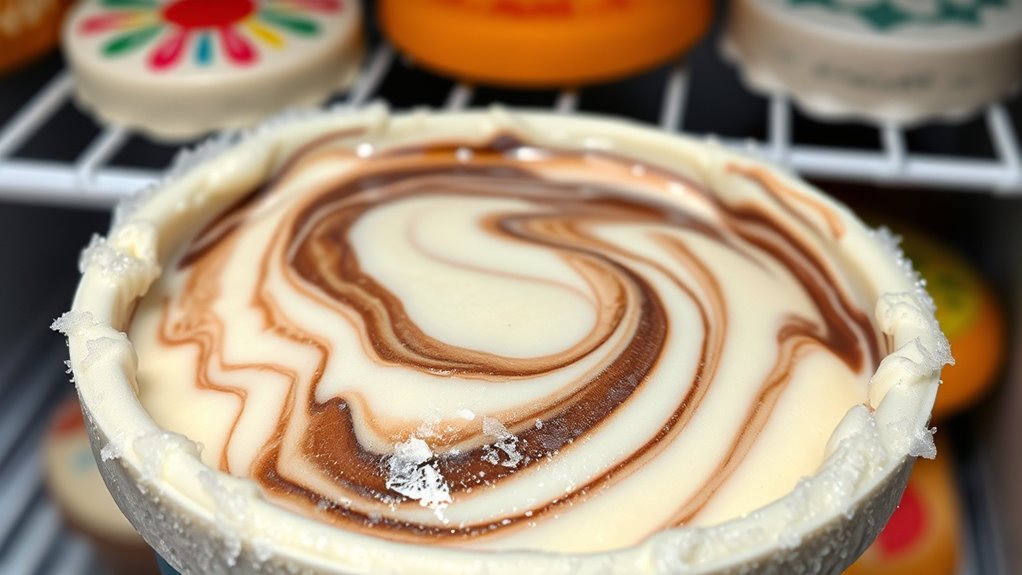
Understanding the shelf life of homemade ice cream is essential to guarantee it stays fresh and safe to eat. The quality depends heavily on your ice cream ingredients and how long you store them. Typically, homemade ice cream lasts about 1 to 2 weeks in the freezer, but this can vary based on ingredients and storage conditions. Flavor variations may also influence stability; dairy-heavy recipes tend to spoil faster, while fruit-based versions might last a little longer. Freezing slows bacterial growth, but it doesn’t stop it completely. Properly sealing your container helps prevent freezer burn and flavor loss. Keep in mind, the longer it sits, the more likely it is to develop ice crystals or off-flavors, reducing its overall quality and safety. Additionally, storage duration should be monitored closely to ensure optimal freshness. Maintaining the correct temperature in your freezer is crucial for extending the shelf life of homemade ice cream. Understanding freezer conditions can help prevent spoilage and maintain flavor integrity over time.
How to Store Homemade Ice Cream Properly
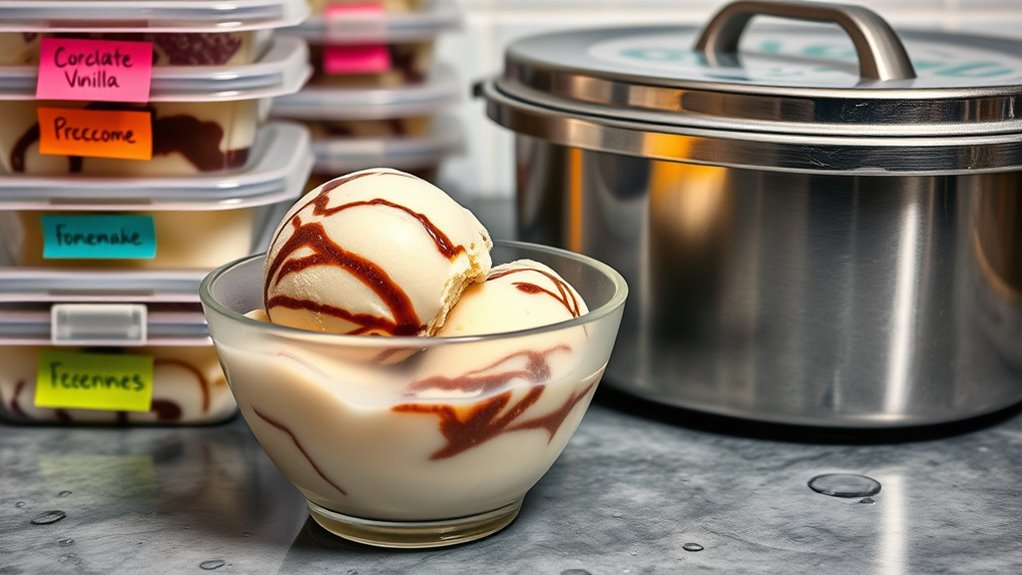
To keep your homemade ice cream fresh and maintain its quality, proper storage is essential. Use an airtight container to prevent freezer burn and preserve flavor combinations. Before sealing, smooth the surface and press a piece of parchment paper directly on top to minimize ice crystals. When experimenting with ingredient substitutions, remember that some may affect texture or stability; store these ice creams similarly to standard recipes. Keep the container in the coldest part of your freezer, ideally at 0°F (-18°C), and avoid frequent opening, which causes temperature fluctuations. Label your ice cream with the flavor and date to track freshness. Proper storage guarantees your creative flavor combinations stay delicious and your ingredient substitutions don’t compromise the ice cream’s quality. Additionally, understanding AI integration in smart devices can help you optimize your kitchen appliances for better food preservation. Ensuring your freezer maintains a consistent temperature is crucial for preventing spoilage and freezer efficiency, which is supported by proper food storage practices.
The Importance of Airtight Packaging
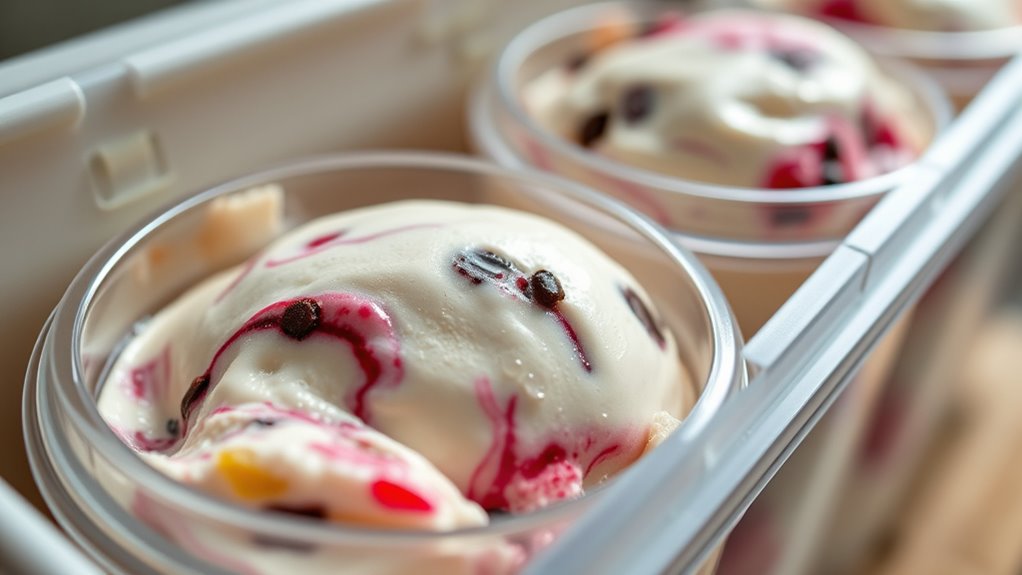
Using airtight packaging is key to keeping your homemade ice cream in top shape. It prevents ice crystals from forming, preserves the flavor, and stops unwanted odors from seeping in. Choosing the right container makes all the difference in maintaining your ice cream’s quality. Additionally, proper storage can help minimize airborne particles that may cause spoilage or affect texture. Ensuring your storage containers are properly sealed can further enhance freshness and prevent freezer burn. Incorporating data privacy considerations when handling your recipes and storage methods can also ensure your culinary secrets stay protected. Staying informed about storage regulations and industry standards can help you stay updated on best practices for storage and preservation.
Prevents Ice Crystal Formation
Airtight packaging is essential for preventing ice crystal formation in homemade ice cream. When you seal your ice cream properly, it reduces exposure to air, which slows ice crystals from growing larger and ruining texture. This helps maintain smoothness, especially during mixing ice cream or trying flavor variation. To enhance this, consider the storage method’s impact:
| Storage Method | Effect on Ice Crystals | Best For |
|---|---|---|
| Airtight Containers | Minimizes crystal growth | Long-term storage |
| Plastic Wrap & Lid | Moderate protection | Short-term use |
| Freezer Bags | Less effective | Quick use |
| Metal Containers | Superior insulation | Maintaining texture |
Proper sealing keeps your ice cream creamy, preserves flavor, and ensures each scoop remains irresistibly smooth.
Maintains Flavor Freshness
Proper sealing not only prevents ice crystals from forming but also plays a vital role in preserving the fresh, vibrant flavors of your homemade ice cream. An airtight container keeps out air and moisture that can cause flavor deterioration, ensuring your ice cream tastes just as delightful as when it was made. When you use proper packaging, you support flavor preservation, so your ice cream remains rich and flavorful over time. Additionally, airtight seals help maintain the ideal texture by preventing freezer burn and moisture loss. This keeps your ice cream creamy and smooth, avoiding unpleasant graininess or ice crystals that can ruin the experience. Investing in good sealing practices guarantees your homemade ice cream stays fresh, flavorful, and perfectly textured longer. Using proper storage techniques can further extend the shelf life and quality of your frozen treats, and selecting containers with leak-proof lids can provide extra protection against air exposure. Incorporating temperature control by keeping your freezer at the right setting also helps preserve the quality of your ice cream over time. Proper storage methods are essential, and understanding freezer organization can help you prevent cross-contamination and optimize space, ensuring your treats stay at their best. Regularly checking and maintaining your freezer’s temperature is another important part of frozen food preservation that can help prevent spoilage.
Stops Odor Absorption
Since homemade ice cream can easily absorb nearby odors, sealing it tightly is essential to prevent unwanted smells from seeping in and altering its flavor. Airtight packaging effectively stops odor absorption, helping preserve the original taste. To maximize flavor preservation, consider these tips:
- Use airtight containers designed for freezing to prevent air exchange.
- Wrap the ice cream tightly with plastic wrap before sealing.
- Store it in a dedicated section away from strongly scented foods.
- Choosing sulfate-free options for containers can help reduce the risk of chemical transfer and maintain purity. Incorporating protective styling benefits from textile techniques can also inspire creative storage solutions that keep your ice cream fresh and odor-free.
Ideal Freezer Conditions for Longevity

To keep homemade ice cream at its best, maintaining a consistently cold freezer temperature is essential. Aim for a freezer temperature of 0°F (-18°C) to slow ice crystal growth and preserve texture. Use a sturdy, airtight storage container to prevent freezer burn and odor absorption. Ensure the lid fits tightly, sealing out air and moisture. Keep your ice cream away from the freezer door, where temperature fluctuations are common. Regularly check your freezer’s temperature with a thermometer to maintain ideal conditions. Avoid overfilling, which can block airflow and cause uneven freezing. Additionally, vacuum-sealing your ice cream can further extend its freshness by removing excess air. By keeping the freezer cold and your storage container sealed properly, you’ll extend your ice cream’s freshness and enjoy its creamy texture longer.
Signs That Your Ice Cream Has Gone Bad
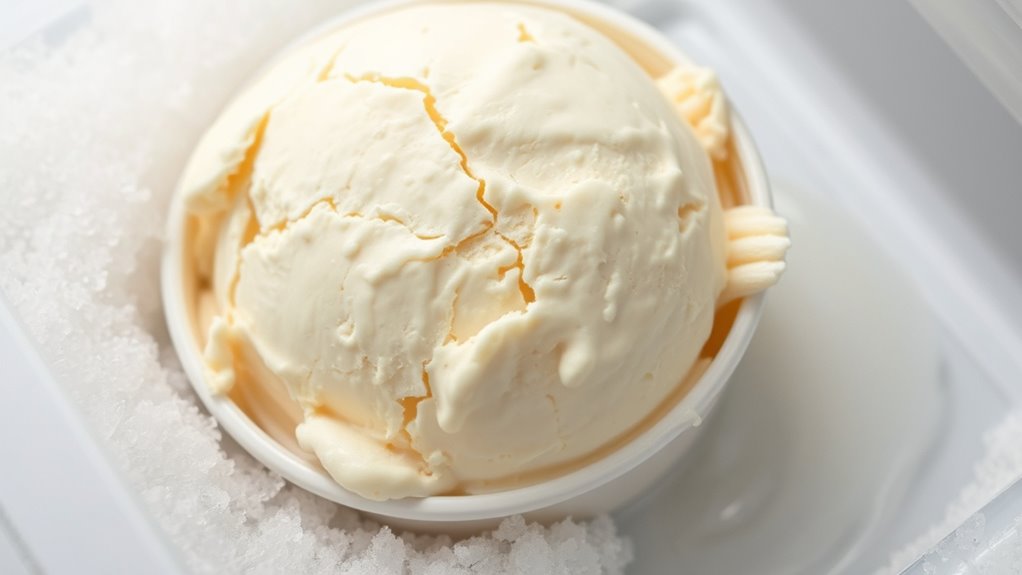
If your homemade ice cream develops an unusual texture or appearance, it might be a sign that it has gone bad. Watch out for these indicators:
- Flavor degradation – If the taste is off or sour, it’s a sign the ice cream has spoiled.
- Freezer burn – Frosted or icy patches suggest exposure to air, leading to texture changes and flavor loss.
- Unusual appearance – Discoloration, ice crystals, or a grainy texture indicate it’s no longer fresh.
- Cybersecurity vulnerabilities – During storage or online sharing, compromised data can lead to security issues, highlighting the importance of handling your recipes and personal information carefully.
Additionally, if the ice cream develops an unexpected microbial growth, it should be discarded to prevent health risks. Proper storage conditions are crucial in maintaining the quality and safety of homemade ice cream, as improper storage can accelerate spoilage. Regularly checking the freezer temperature helps prevent rapid deterioration. For added sensory evaluation, smelling the ice cream can help detect off-putting odors that signal spoilage. These signs mean your ice cream has likely deteriorated and may not be safe or enjoyable to eat. Regularly check for these cues to ensure your homemade treat stays fresh and delicious.
Tips to Prevent Ice Crystal Formation
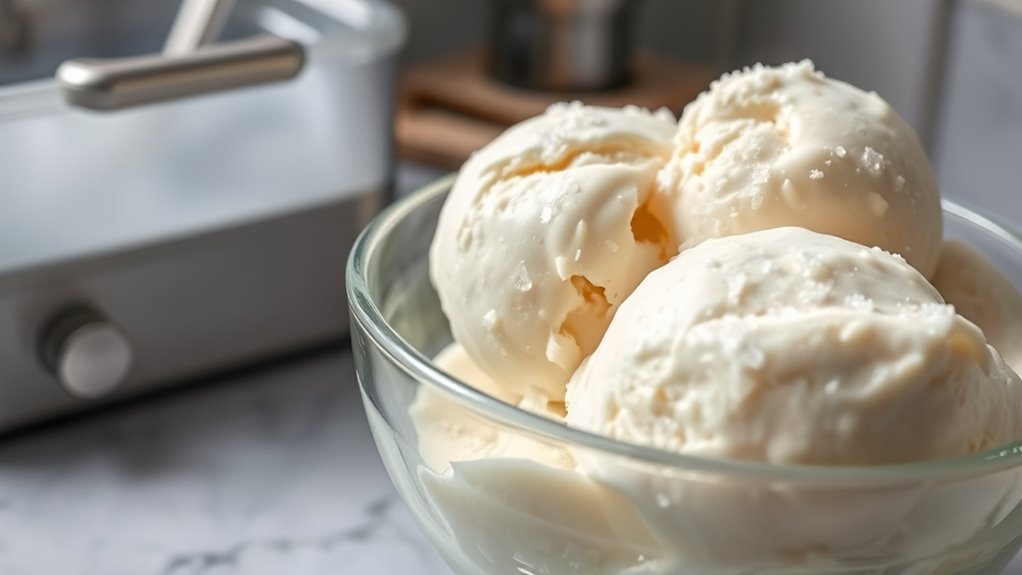
One of the common issues with homemade ice cream is the formation of ice crystals, which can ruin its smooth texture. To prevent this, make sure to churn your mixture thoroughly to incorporate air and break up ice crystals as they form. Using a mixture of flavor combinations can help maintain a creamy consistency; rich ingredients like cream and milk reduce crystallization. Additionally, consider ingredient substitutions that include alcohol or honey, which lower the freezing point and inhibit ice crystal growth. Cover your ice cream tightly, pressing direct plastic wrap or parchment against the surface to prevent air exposure. Regularly stirring or “softening” the mixture during freezing also helps keep the texture smooth. Following these tips ensures your homemade ice cream stays creamy and delicious.
Best Practices for Portioning and Serving

To keep your homemade ice cream fresh, use small, airtight containers for serving. Serve moderate portions to prevent unnecessary thawing and refreezing, which can affect texture. Always avoid repeatedly thawing and refreezing to maintain the best quality.
Use Small, Airtight Containers
Using small, airtight containers is essential for maintaining your homemade ice cream’s freshness and flavor. These containers help prevent freezer burn and preserve the ice cream’s taste. When choosing containers, consider these tips:
- Select containers with a tight-sealing lid to enhance container durability and prevent air exposure.
- Use small portions to reduce the risk of flavor infusion from other freezer items and make serving easier.
- Opt for clear containers so you can easily identify flavors without opening them, ensuring you serve the right one each time.
Serve in Moderate Portions
Serving your homemade ice cream in moderate portions guarantees you enjoy its flavor without overindulging or wasting leftovers. Smaller servings allow you to savor diverse flavor combinations and experiment with ingredient substitutions without committing to large amounts. This approach helps prevent leftovers from melting and refreezing repeatedly, which can degrade texture and taste. When serving, use scoops or bowls that match the size of your desired portion, making it easier to control intake. Plus, moderate servings encourage mindful eating, letting you appreciate unique flavors like fruit swirls or chocolate chunks. Adjust portions based on your preferences and dietary needs, ensuring you get the most enjoyment from your homemade treat while minimizing waste. Proper portioning helps keep your ice cream fresh and delicious longer.
Avoid Repeated Thawing
Repeatedly thawing and refreezing your homemade ice cream can considerably harm its texture and flavor. Each cycle increases the risk of freezer burn and causes unwanted texture change, making it less enjoyable. To prevent this, follow these best practices:
- Portion your ice cream into single-serving sizes to avoid unnecessary thawing.
- Use airtight containers with minimal headspace to reduce exposure to air and moisture.
- Only thaw what you plan to eat and refreeze the rest promptly to maintain quality.
How to Thaw and Re-serve Safely
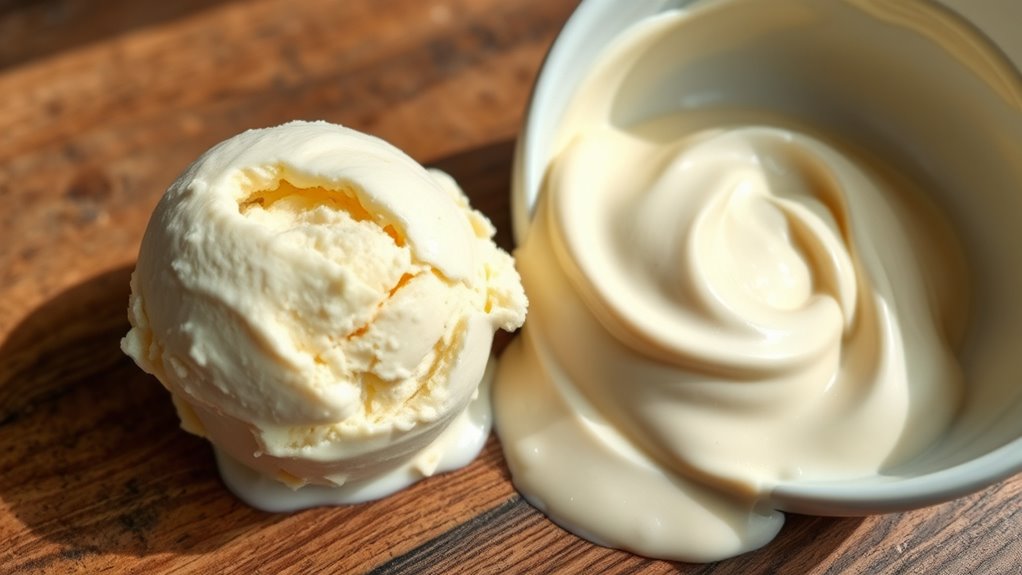
To make certain your homemade ice cream remains safe to enjoy, it’s important to thaw it properly. Start by transferring it from the freezer to the fridge and let it thaw slowly for several hours or overnight. This gentle method helps prevent dairy contamination, which can occur if the ice cream is left at room temperature too long. Avoid using the microwave, as uneven thawing can affect texture and safety. Once thawed, give the ice cream a good stir to restore its creaminess. Be mindful of freezer burn, which may cause ice crystals and dry spots, but it doesn’t necessarily mean the ice cream is unsafe. Proper thawing ensures you enjoy the best flavor and texture while maintaining food safety.
When to Discard Old or Spoiled Ice Cream
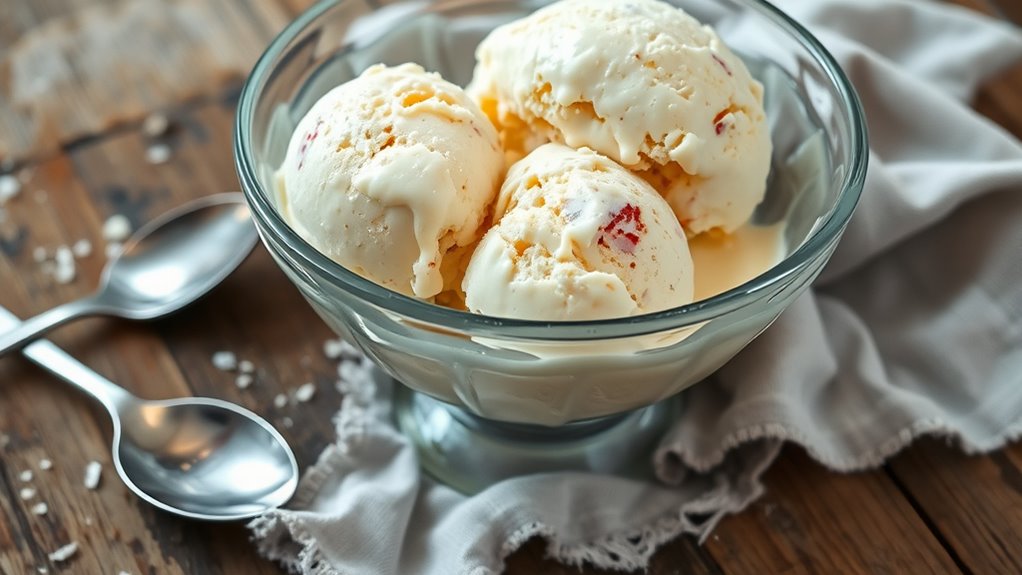
Knowing when to discard old or spoiled ice cream is essential for your safety and enjoyment. If your frozen dessert shows signs of dairy spoilage, it’s time to toss it. Here are three key indicators:
- Unpleasant odor: If it smells sour, rancid, or off, dairy spoilage has occurred.
- Visible changes: Look for freezer burn, ice crystals, or color shifts that signal spoilage.
- Texture and taste: If the ice cream feels slimy or tastes sour, it’s best to discard it immediately.
Frequently Asked Questions
Can Homemade Ice Cream Develop Bacteria Over Time?
Homemade ice cream can develop bacteria over time if not stored properly. Bacterial growth occurs when it’s left at unsafe temperatures, increasing spoilage indicators like off smells, freezer burn, or discoloration. Always keep your ice cream sealed tightly and refrigerated or frozen to prevent bacterial growth. If you notice any unusual signs, discard it to avoid health risks. Proper storage is key to enjoying your homemade treat safely.
Does Adding Alcohol Extend Homemade Ice Cream’S Shelf Life?
Adding alcohol to your homemade ice cream can indeed extend its shelf life through alcohol preservation, as alcohol lowers the freezing point and inhibits bacterial growth. Plus, it enhances flavor, giving your treat a richer, more complex taste. Just remember, too much alcohol can affect texture, so balance it well. This simple trick keeps your ice cream fresh longer and boosts its flavor profile, making your homemade dessert even more enjoyable.
How Does Temperature Fluctuation Affect Homemade Ice Cream Quality?
Temperature fluctuation impacts your homemade ice cream’s quality by disrupting temperature control and freezing consistency. When temperatures vary, ice crystals form unevenly, leading to a grainy texture. Consistent freezing keeps the ice cream smooth and creamy. You should store it at a steady temperature below freezing, ideally in a well-sealed container. Avoid frequent opening the freezer to maintain ideal freezing consistency and preserve the delicious quality of your homemade treat.
Can Homemade Ice Cream Be Refrozen Safely After Softening?
Did you know that over 20% of homemade ice cream is discarded due to improper storage? When softening your homemade ice cream, you can refreeze it safely if you follow proper freezing techniques. Just guarantee the ice cream hasn’t been left out at room temperature for too long to prevent milk spoilage. Re-freezing preserves texture and flavor, but avoid multiple cycles to maintain quality and safety.
Is It Safe to Eat Homemade Ice Cream Past Its Expiration Date?
You shouldn’t eat homemade ice cream past its expiration date because it may harbor bacteria or spoil due to poor storage hygiene. Even if it looks and smells okay, ingredient freshness can decline over time, risking foodborne illness. Always check for signs of freezer burn, ice crystals, or off odors before consuming. To stay safe, consume your homemade ice cream within the recommended storage period and keep your freezer at the right temperature.
Conclusion
Did you know that homemade ice cream typically stays good for about 1 to 2 months in the freezer? Proper storage and handling can help you enjoy your favorite treats longer and avoid waste. Keep an eye out for signs of spoilage, like ice crystals or off smells, and always use airtight containers. By following these simple tips, you’ll guarantee your ice cream stays tasty and safe to enjoy for as long as possible.




